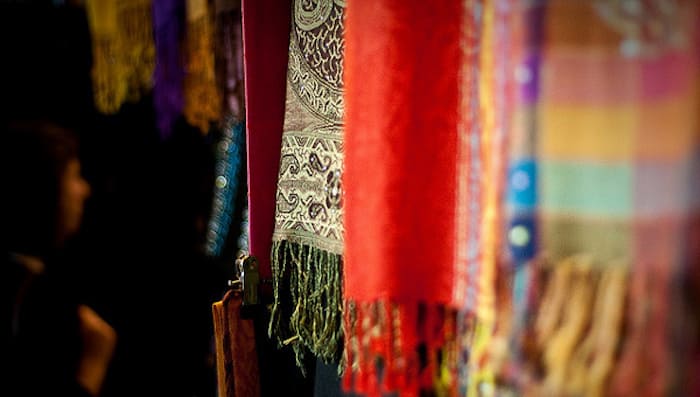Having been born in one of the World’s most secluded areas, Pashmina is a timeless beauty that has paved its path to high fashion boutiques and closets. It has been consistent to be popular and one of the most desired fabrics in the fashion industry. Pashmina in Nepal comes from farmers living in some of the most remote places in the Himalayas.
Nepal has had a rich history of producing Chyangra goats, and using the animal-hair form their undercoat to create Pashmina products. In this blog I discuss what Pashmina is, how it is made, and ways to tell if Pashmina is real or fake while buying it in the local bazaars.
What is Pashmina?
Pashmina, known as cashmere or cashmere wool, comes from the Persian dialect – Pashm, which refers to premium quality wool fiber. Over the centuries, pashmina is known to come from a special kind of wool, that comes from a Himalayan goat known as Capra hircus, and Chyangra in local language living in the Himalayas at an altitude of 14,000 feet. These goats, sometimes known as a cashmere goat or a pashmina goat, are found in the high plateau regions of Nepal, Tibet and Kashmir.
On average, a human hair is 75 microns thick, normal cashmere is approximately 20 microns and Grade A cashmere is 12 microns thick. Therefore, a premium quality texture of pashmina is six times finer than human hair! Which will mean an incredibly soft cashmere shawl or pashmina wrap.
Pashmina was discovered when Kashmir was under Mughal rule in the 16th century and the Mughal Kings were fascinated by the beauty of the cashmere. As the aesthetics of the Pashmina started to spread more, the French Monarch Napoleon Bonaparte gifted wife with a Pashmina shawl. It is believed that she owned a couple of hundred shawls at that time.
What is Pashmina Made from?
Pashmina is made from a himalayan goat called the Capra hircus or Chyangra. One pashm goat produces around three to eight ounces of fiber which is enough wool to produce one pashmina scarf and three goats to make a shawl. The wool produced by the goat proves to be the best insulator as the thermal conductivity of this wool is very high. Authentic Pashmina wool is too delicate to wear and therefore undergoes a strenuous process to make it soft as silk, which is referred to as cashmere.
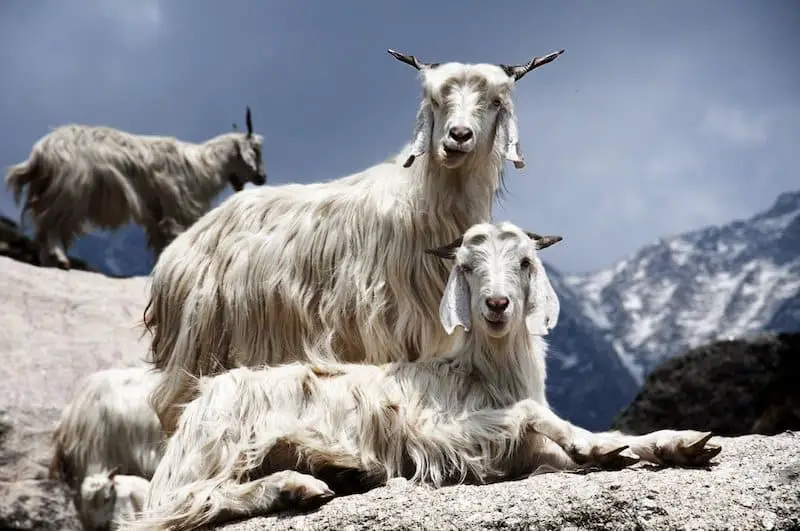
Pashmina is around 12 microns thick and six times finer than human hair. The human hair is 74 microns thick and normal cashmere is approximately 20 microns thick. Therefore, Pashmina is light as a feather and finer than cashmere wool.
How is Pashmina made?
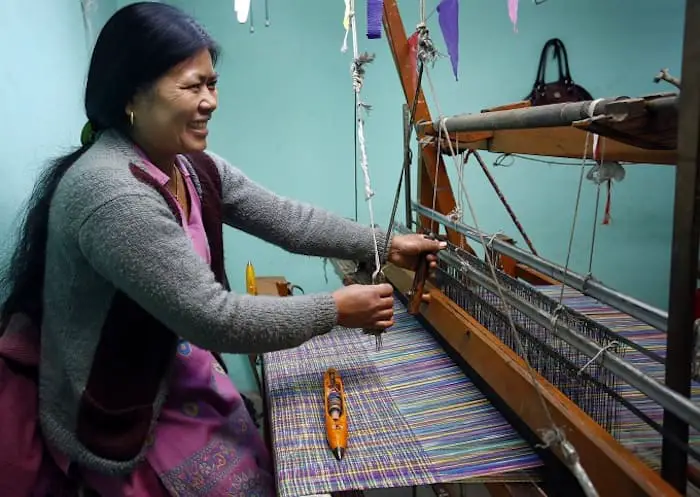
Pashmina completes a journey of 4 crucial steps, from just being a Pashmina thread to being woven into an opulent shawl:
1. Pre-Spinning Process
It takes around three weeks of process to complete a pashmina shawl. The first step begins in the Himalayas where flocks of goats are combed regularly. By combing their hair, it helps to separate the coarser hair to use for pashmina products from the soft, white hair from the under belly which is then used by the cottage industries to produce shawl.
2. Spinning of Pashmina
The production process is a long and detailed one that involves collection of the wool, spinning, weaving, designing and dyeing. It is essential that each step is executed meticulously to maintain its fine quality. Every spring, the fine wool from the chyangra is collected and spun by hand on a silk spinning wheel locally known as charkha. Before the wool is spun, the raw material is treated by stretching and cleaning it to remove dirt. Then, it is soaked in rice water to soften the material. The initial step of the process requires many procedures and is a painstaking step as it demands patience and determination to make the pashmina fiber.
3. Weaving a Shawl
Then comes the weaving process. Due to the fragility of the material, the process is solely dependent on the handlooms. Weaving is an art in its own way and has been passed over generations by the local communities in Nepal. Each and every step is crucial to weave a pashmina – from the design to fringing of a pashmina is a delicate process and requires artistic expertise. The last and essential step is the dyeing of the pashmina. Pashminas are hand-dyed and specifically metal and azo-free dyes are used which makes all Pashmina items an eco-friendly product.
4. Finishing a Pashmina Shawl
The Pashmina is dyed up to nine times over a gas flame and continuously stirred to ensure that colors are even. To produce a shaded shawl, two people stand above the dye pots for an hour holding each end of the pashmina product and lets the color seep through the shawl! After dyeing the shawls, they are washed again and dried outside. After completion of the dyeing process, it is then passed on to the fringe experts. Pashmina’s tassels are rolled on their legs and can fringe upto eight shawls a day. Yet after another washing and drying the shawls are ready for ironing and quality check.
Pashmina is graded according to their quality, the most luxurious being the most sought after Grade A-Diamond quality. Ninety percent of the Pashmina around the world are woven on a warp of silk as silk thread comes with combined strength and great elasticity! However, Pashmina shawls with no silk are so fine that they can be pulled through a wedding ring, hence the term “Ring Shawl”.
From the 19th century in France, Pashmina cashmere shawls became a most desired fashion accessory, hence, beautiful beads, semi-precious stones and embroidered shawls were also produced.
Pashmina in Nepal:
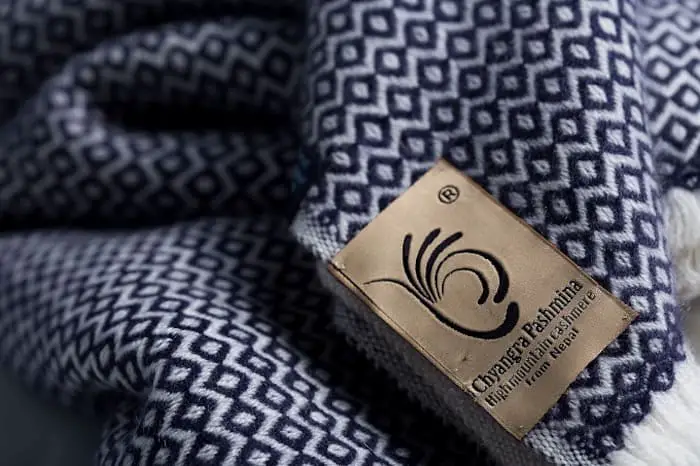
For more than a century, Nepalese artisans have been weaving Pashmina shawls using traditional methods that were passed down from generations. Today, Cashmere Pashmina products have become one of the largest overseas export items from the country and accounts for more than fifty percent of the total export figures in the handicraft sector in the country.
Chyangra Pashmina is the Grade-A, finest cashmere fabric in the world which is produced from the rare Chyangra goat, or mountain goal, of the Nepalese Himalayas. Inspired much by the culture and tradition of Nepal, Pashmina is produced with an ethical handmade production process.
Due to the increased demand and premium quality of Chyangra Pashminas, in 2000 Nepal Pashmina Industries Association (NPIA) was established. They are an autonomous and non-governmental/non-profit organization and representative body and all Nepalese Pashmina entrepreneurs are brought together to create a sustainable development of the industry.
One of the most renowned companies that export Grade-A Pashmina is Chyangra Pashmina. They specifically produce Pashmina that is made from Chyangras, the Himalayan goat. They use one of the oldest methods of manufacturing fabrics, i.e. handloom weaving. To create 100% Chyangra Pashmina they use the yarn in both the warp and weft to produce a variety of products and weaves using pashmina fabric. To ensure that the quality of Pashmina that is produced is at its highest grade, they go through a code of conduct that involves eight steps!
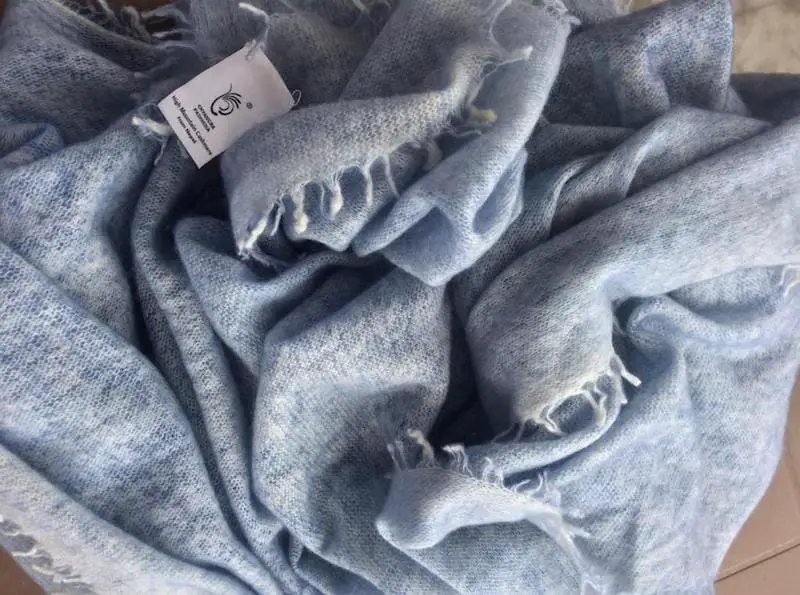
Also shared by many Pashmina exporters in the country, one of the simplest ways to differentiate between a real and a fake Pashmina is to touch and feel the softness and warmth of the fabric. Pashmina is light, soft and warm or some Pashmina also have a silk blend to it, which gives off a slightly shiny tone.
Another tip is to check the label for its accurate fiber content. It should either say 100% cashmere or 70% cashmere and 30% silk. Since, the Government of Nepal also introduced a unique hallmark known as “Chyangra Pashmina”, most Pashminas in Nepal should have the “Chyangra Pashmina” label. To help you differeniate fake from real Pashmina while purchasing the fabric in Nepal, use the following 7 tips.
How to Check if Pashmina is Real or Fake?
It is important to check if the fabric is real or not. Especially when having to pay a significant amount of money for the piece. The 7 ways to check if Pashmina is real or fake are:
1. A 100 percent Pashmina scarf is soft
2. A 100 percent Pashmina scarf will carry a label
3. A 100 percent Pashmina scarf is not transparent
4. Genuine Pashmina is uneven (there will be irregularities in design and feel)
5. Original Pashmina won’t generate static electricity
6. Original Pashmina will Pill
7. A 100 percent Pashmina scarf gives a burnt smell (smells like burnt hair)
Key Takeaways: Pashmina is timeless
Pashmina was, is and will forever be an exquisite clothing. Just as the ancient times, Pashmina is an essential part of stylish clothing of the modern closet. Even Pashmina scarves, stoles and shawls are a popular fashion accessory and attracts many eyes. An authentic Pashmina is a soft and luxurious gift of nature which indicates attractiveness and endurance of this timeless fashion accessory.
Pashmina is truly an eccentric combination of traditional workmanship and stylish beauty, a piece of history interwoven into embroideries and elegant designs, and which is probably on the softest, warmest and most exquisite indulgences money can buy!
If you are interested in finding out more about Nepali culture, check out my blogs about traditional food in Nepal, or traditional dresses in Nepal. We also discuss how burning incense sticks plays an important part in Nepalese traditions in famous temples around Nepal.
